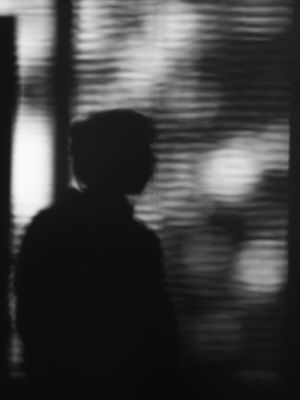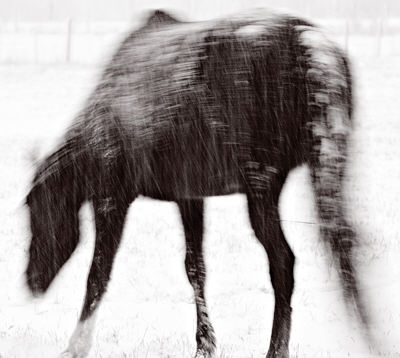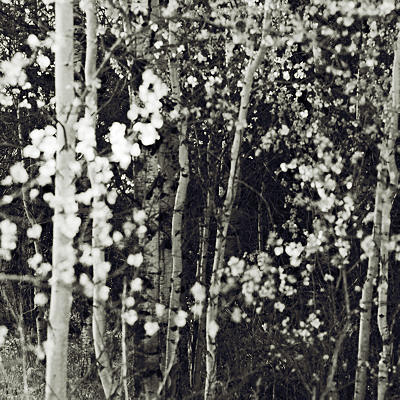
Photographs are tied to place, and my normal practice is to revisit a place repeatedly, attempting to know and see it better. Perhaps less obviously, photographs are also tied to time. Some of the most striking are tied to a moment that can never return. But that’s seldom the case for me: usually the relevant time is seasonal, and will probably recur next year for perhaps a week or, if I’m lucky, a month. The photograph here, though, had unusually stringent constraints: it could only be made within a few minutes of sunrise on a couple days of the year, when the sun is behind a certain tree about twenty-five yards from my office window.
When I first made such a photograph, in 2006, I was simply intrigued by the pattern of light and shade. And that’s mainly what kept me on the lookout for the phenomenon in 2007. But we’d also had recent discussions about self-portraits on A&P (from Richard and Sunil), and that idea was also in my mind. Not that I was trying to make any definitive statement, but I thought that one aspect of myself might come through, namely the inscrutable me gazing on the world, thoughts (if any) vague and inexpressible. The self-conscious quality is not inappropriate. The ironic title of this post also dates from last summer. Doubly ironic, as the subject is not exactly me, but a shadow of me cast on a wall.
I happened to notice the stored image this weekend, and I realized that my formal interest in the optical effect was related to my not-quite-explicit attempts to play with interesting and unsharp textures, which are also at the fore in both recent and early work.


Oddly, to me that minor artistic realization feels more important, at least for now, than “deeper” questions of identity or epistemology. Perhaps that’s because a big part of my current identity is, in fact, about trying to understand what I’m doing artistically.
In time I may come to appreciate it more, but for me and for now this potentially meaningful work seems to have a more surface importance. I would rather make an apparently superficial photograph that slowly reveals its deeper significance.
How do you like your profound meaning in art? Should it come announced or sneak up on you?

Steve,
Today’s photo is great,I like it even better than last year’s one.
What you say about yourself today makes sense. I do see you more as the ‘intellectual’ type interested in optics and pattern recognition than the emotional type, dealing with your life.
Perhaps, what you are talking about happened to me when I thought that I was dealing with my ‘height’ issues doing dune photography but instead became interested in gender issues.(I cannot get the link to be pretty. Also, ‘innate expression’ shows up as ‘fall dune’ in the url.)
Birgit,
Well, I think you’re partly right about me, but there’s probably some distortion in that what I write about on A&P about my own art is weighted towards technique and eliciting reactions from other viewers. While I certainly feel an affinity for the patterns and optical effects “for their own sake,” ultimately I’m exploring what that unexplained affinity for some aspects of the medium tells me about myself and how I see the world. I guess what I’m saying is that, for now anyway, I find that roundabout path to self-exploration more compelling than something like “making a self-portrait that reveals the depths of my soul.”
Yes, the way your work led to thinking about other issues is very much the way I like it to happen. [Your link seems to work and the comment is clear enough, so I’m not going to attempt surgery on it.]
Steve:
I like the implied thought balloon behind your head. The “rays” of light created by the blinds have an intriguing relationship to the silhouette – they enter the silhouette and are sublimated into the balloon. ‘Blinded by the Light”.
Is that diapered apparition Richard Rothstein? My reason for asking harks to the enjoyment I get from trying to guess the appearance of posters. I’ve seen June off and on since college, Birgit maybe from some of her posts, Sunil from a newspaper clipping, David surely, “D” and his father, a couple of painted Angelas, Doug Plummer from his blog etc. Steve Durbin remains “inscrutable”. Please leave it like that as I find myself making subtle adjustments to a mental image of a lean, Doug Plummerish and fortyish individual who projects a sense of patient anticipation. Quiet. Related to Sen. Durbin. Oh, how wrong can one be! (cue the sackcloth and ashes) But please – no mug shots as I’m having a good time with this guessing game. You are wearing a shirt with a collar which says ‘office’ and also Bill Gates.
Steve,
I didn’t mean to imply that your interests are not artistic in their origin only that the ‘coloration’ is different, an important question in itself.
Steve,
I have to think further on this post and its ideas because they are ones I’ve pursued through my art and my ruminations.
But instantly I am reminded of one of Richard’s photographs, of a guy gazing out a window in NYC. What is it about windows and the turned away gaze?
I’ll be back later.
Windows?
There is a terrific scene in Miranda July’s film, “You and Me and Everyone We Know”, where a single guy leaves creepy written messages in the front window of his first-floor apartment for two teenage girls who regularly pass by. Though their identities are know, this Other inter-action is never direct until…
Also, Laura Barnett:
http://www.chashama.org/info/io/io-l.barnett-bio.htm
Steve, the thing that engages me about the top two photos, as well as the one you’ve linked to from April, is that there’s a sort of interference between me (as viewer) and the subject, that adds a layer of mystery, and also makes them feel more like true experience than most photographs.
In my experience of the world, things are moving and changing, they are half-glimpsed and just-missed, and from all of those fragments of information I try to piece together a world. These new photos of yours operate on that level. I look forward to seeing more.
David,
That reminds me of a discussion we had that brought up Richard Tuttle’s claim that art is the only way to experience reality.
That sense of a dislocation from the “real” world is, indeed, something I’m very interested in, and I think that a lot of my playing with abstraction involves giving a viewer a bit of a pause, making them work harder in their own mind (consciously or not) to make sense of the image.
D.,
Interesting, it looks like windows in both the cases you mention are primarily for looking at and through from the outside. The window/eye metaphor has quite different connotations when one is looking outward from inside. Though one would imply the other…project ideas…
Steve, Tuttle’s comment is catchy, but it doesn’t make a whole lot of sense to me. Certainly there are many things we can call reality, and many ways to experience it.
I don’t see your new imagery as dislocations, exactly, but as partially obscured views. Which, for me, captures experience more fully. There’s something about raising the noise in the signal-to-noise ratio that enhances the emotional impact of the images. Maybe because it echoes, to a certain extent, our own frustrated attempts to see the world clearly.
June:
You might agree with me that the turned away gaze can also be a turned toward gaze. For me there’s an empathetic reaction when I see somebody staring: I’ll look there too. It’s like the old business of staring upwards emphatically, with pointed finger – it tends to draw a crowd. The nude facing the New York skyline creates a tension in that the nude, as a nude in this case, is meant to be seen in a special context. One’s focus might be drawn to the specter of nakedness at one level and simultaneously – or sequentially – drawn out the window. In this case I would tend to identify the skyline as backdrop, but what if the guy appears absorbed in what he sees out there? In line with David’s comment this might be experienced as a kind of interference arising between differing kinds of messages. A.M. radio used to be like that, where one might simultaneously pick up a rock and roll station, the local news and the Grand ‘Ole Opry. The effect could be a delicious cacophony, the shows’ climbing all over each other, and the effect better than any one station alone.
I’m put in mind of some of Hopper’s paintings.
Back to Steve’s first photo. Is he looking out the window or back at us? A backward gaze is inferred in that he had seen his shadow at an earlier time and scheduled an opportunity to capture it. Maybe Shroedinger’s cat took the shot.
Jay,
I’m put in mind of some of Hopper’s paintings. Which ones?
Jay,
Schrodinger’s cat gets blamed for many things, somewhat like el brazo Onofre (Milagro Beanfield War). As for the direction I’m looking, it’s more towards the shadow (away from the camera), so that I can see the composition before tripping the shutter.
Birgit:
Can’t remember the name, but a woman in a slip sits on a bed while looking pensively out a window. She is turned toward a seemingly unlimited sky, but appears to be seeing her own thoughts.
Steve:
I have never seen Milagro, but I understand that it pertains to a social system involving the maintenance and sharing of waterways in New Mexico. At least Senor Onofre isn’t wanted dead or alive by a posse of physicists.
Jay,
I know that picture. It has a haunting quality.
I always thought “what we see when we turn away” would be a good title. Unfortunately, I have not yet been equal to the task of making something to match it. Someone should take it!
As far as taking my profundity, I like to see it out of the corner of my eye. Everything in the peripheral has more possibility than what’s in front of you. Things (idea for work, truths,even feelings about people) tend to whither under a direct gaze. Better to half perceive something and believe it could be something profound than to look head on and convince yourself its not.
That’s the fun of this photograph–the speculation.
McFawn:
You have a point. If I remember, one of the techniques taught by Don Juan Mateus, in reaching a state of heightened awareness, was to see the world out of focus and without specific visual attachments. Nighttime for me is so beguiling in part because the darkness tends to preclude focus upon specifics and sources of light seem to emerge from a kind of primal state.
But a direct gaze deserves a good word. Lock onto something with your eyes and keep it up past the boredom. At some point the obviously familiar undergoes a transformation. It’s akin to a long and repetitive recitation of a single word as the accustomed associations fall away.
McFawn,
That’s a great title, and could do as well for a book as for a painting. In a sense, it truly applies to figurative painting (or drawing, etc.) in that one is looking away from the subject when actually rendering it. I think that must feel quite different from photography. There I continuously observe the scene before me until activating the shutter (though I may have some other image in mind at the same time). Later, developing the image, I no longer have access to the subject.
Your concept of peripheral seeing is somewhat like David’s seeing through an interfering veil. Part of the way this works, I think, is by inducing the viewer to fill in gaps, to speculate.
Jay,
I’m also attracted to nighttime views, and your reasoning makes sense to me. Except that rather than preclude focus on specifics, I would say we are given a few prominent specifics (whatever is in light) and are left to peer and guess at what’s in the dark.
Steve:
Size matters as it would appear that you have a bigger specific than I. I’m referring to the detail within the silhouette that goes missing in the dark. A good place to see this is L.A., and particularly in Hollywood Forever cemetery. I was there one night to see a play and was struck by the slender bulk of palm trees etched in cutout mode against a smoggy nighttime haze.
I’ve been thinking a lot about David’s comment 7, and it strongly resonated with a passage I just read from Pierre Bayard. Writing about our relation to books, he says (my translation) it is not
The passage also reminds me of my old statement about the Ghost Light project.